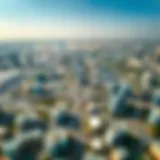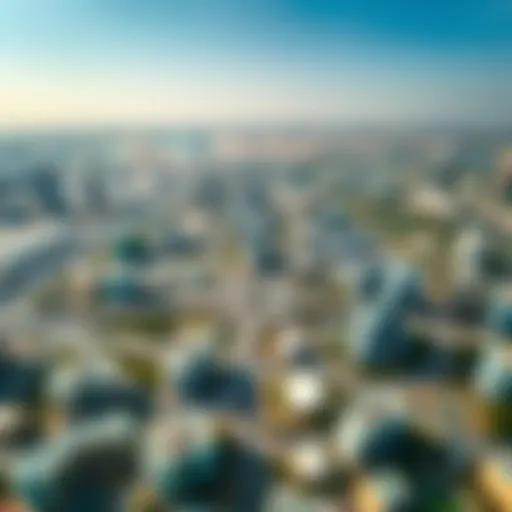Exploring City Walks: Discover Dubai's Urban Charm
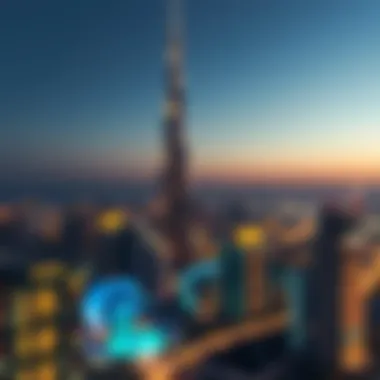
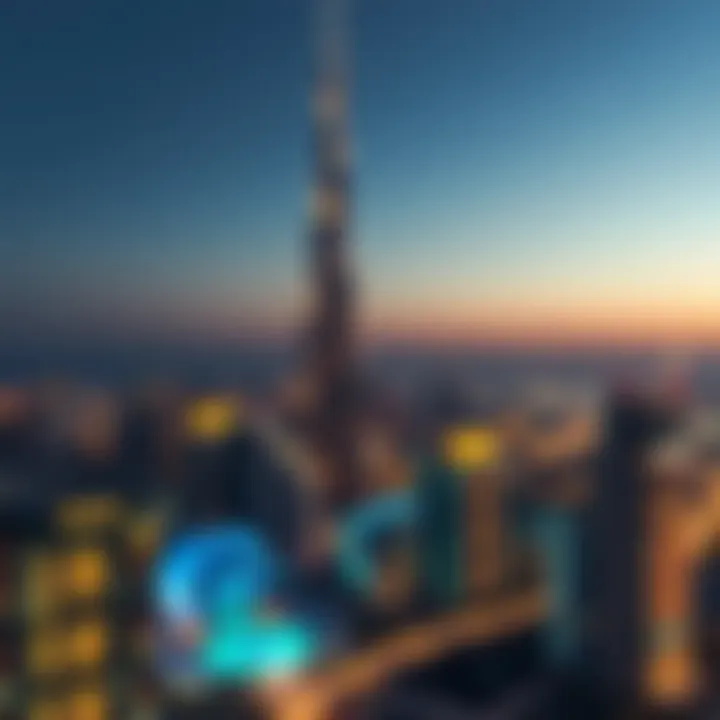
Intro
Dubai is not just a city built on sand and steel; it’s a veritable tapestry woven from diverse cultures, remarkable history, and strides towards modernity. As one takes to the bustling avenues, what unfolds is a profound narrative—a tale of transformation from a modest trading post to a global metropolis. Understanding the significance of city walks in this tantalizing desert oasis requires not just a stroll through its vibrant streets but a diving into the intricate fabric that shapes the urban experience.
Exploring the city on foot offers a unique lens through which potential homeowners, investors, and expatriates can gain insight into real estate trends, community dynamics, and cultural vitality. The whimsy of unplanned discoveries, be it a hidden café or an art gallery pulsating with the colors of local talent, can provide invaluable context to anyone wanting to plant roots in Dubai.
In this guide, we will traverse key aspects of city walks, including the must-see landmarks, architectural marvels, and cultural gems sprinkled throughout the emirate. Armed with knowledge about market trends and viable investment options, readers will come away informed and enlightened about not only what to see but also where they might fit into this vibrant living mosaic.
Preface to Dubai's Urban Walkability
In recent years, the discussion around urban environments has included a spotlight on walkability, and Dubai is no exception to this trend. Walkability in Dubai is more than just a definition; it's a lens through which one can understand the city's pulsating rhythm, cultural hotspots, and evolving neighborhoods. This focus becomes crucial not only for the casual observer but also for serious investors and homeowners looking to dive into the real estate market. Understanding walkability provides insight into how neighborhoods can transform, affecting both lifestyle and property values.
Defining City Walks
When we talk about city walks in a place like Dubai, we refer to more than just strolls down tidy pathways. City walks encompass planned routes that reveal the city's character, its hidden gems, and the social fabric of its neighborhoods. These walks can include everything from promenades along the Dubai Marina, where thrilling views and luxury shops abound, to quieter streets in Al Fahidi, where history greets you at every corner.
Moreover, city walks serve as a bridge between the past and the present. They can encourage residents and tourists alike to engage with the environment, giving them the chance to slow down and absorb the culture and landscape around them.
Historical Context of Urban Design in Dubai
Delving into the urban design of Dubai requires an understanding of its rapid development. From a humble coastal town to a modern metropolis, Dubai's planning strategies have evolved significantly. city walks reflect this evolution, showcasing a blend of traditional designs and avant-garde architecture.
In the early years, urban design was largely influenced by functionality—areas were planned based on trade needs and population growth. The rapid embrace of modernist architecture began in the late 20th century, spurring some spectacular structures such as the Burj Khalifa and the Dubai Mall.
Today, urban planners are increasingly conscious of sustainability and human-centric* designs. Walkable districts are seen as essential for the well-being of residents and tourists alike, not merely as a means to traverse the city but as a way to enhance emotional and social connections. By examining these structures, one can perceive the social, economic, and cultural narratives that have influenced Dubai and continue to shape its future.
Significance of City Walks in Real Estate Understanding
City walks in Dubai present a unique lens through which one can understand the real estate market dynamics. The interplay between urban infrastructure, community engagement, and property values is crucial for potential investors and homeowners. Walking through the vibrant streets and neighborhoods not only offers a glimpse into the architectural allure of Dubai but also reveals the underlying trends that govern its real estate landscape.
The essence of city walks lies in their potential to illuminate the character of different locales. Each district in Dubai tells its own story, and it's through the act of walking that one can appreciate the nuances. Look beyond the glossy skyscrapers and delve into small eateries, art installations, and local parks, which are often the lifeblood of a community. This immersion is invaluable for those looking to invest in properties or settle down in the city.
How City Walks Influence Property Values
The correlation between city walkability and property values is something that savvy investors should take note of. Areas well-equipped for pedestrian traffic, such as Downtown Dubai or Dubai Marina, typically experience higher demand. These neighborhoods attract both tenants and buyers, leading to increased prices per square foot. When city walks are designed with thoughtfulness, featuring amenities like shops and public transport, they naturally become hotspots in the real estate market.
To further illustrate this point:
- Properties in walkable neighborhoods see a quicker turnover.
- High foot traffic areas often host a rise in cafes and boutique shops, thereby enhancing property desirability.
- Families and young professionals show a preference for locations where leisure and work can be accessed on foot, thus elevating the value of nearby residences.
In essence, city walks contribute to a sense of community, and the higher the foot traffic, the more attractive the real estate becomes. Investors must assess the walkability of an area not just for the current appeal but for its future growth potential as well.
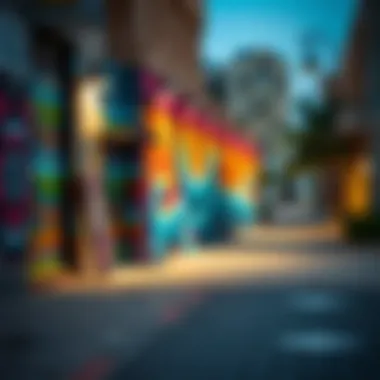
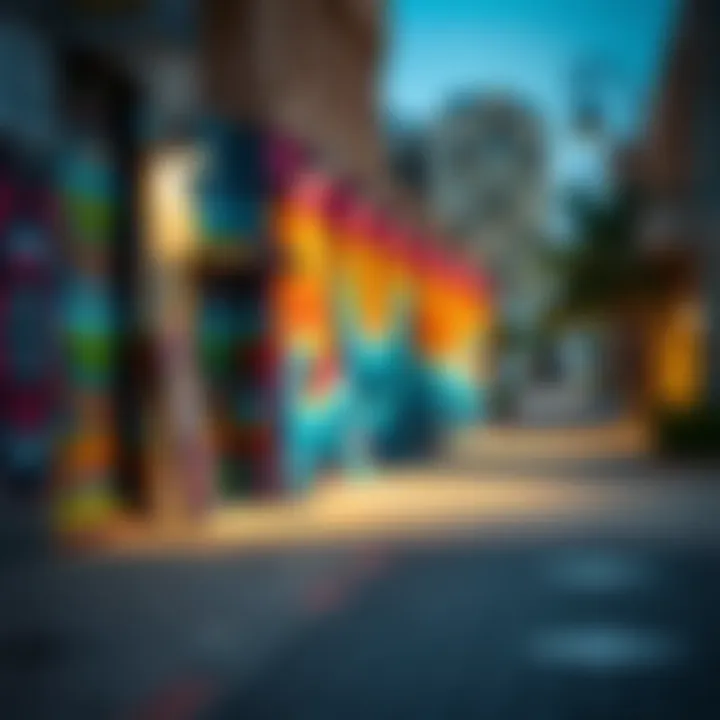
Neighborhood Dynamics and Social Interaction
Exploring Dubai’s city walks reveals the intricate social fabric that weaves through its neighborhoods. Each pathway presents an opportunity for connection among residents. People stop to chat, share a meal, or appreciate art; these moments cannot be replicated through digital interactions. Understanding these dynamics is essential for anyone hoping to thrive in the real estate market provided by this vibrant city.
For potential homeowners, the neighborhoods that foster a lively atmosphere often lead to stronger community ties. Factors to consider when evaluating neighborhoods include:
- Local Events: Food festivals and cultural activities engage residents and foster an inviting environment.
- Public Spaces: Parks and open areas encourage socializing, turning houses into homes.
- Diversity of Offering: Variety in shops and services caters to different demographics, making every corner feel alive.
Integrating into the cityscape through footpaths and urban trails grants insight into what everyday life looks like. For real estate investors, recognizing these elemental aspects can guide smart investments, ensuring that they capitalize on neighborhoods that not only have potential but are also enriched by community vibrancy.
Key Areas for City Walks in Dubai
City walks in Dubai play an essential role in shaping the urban experience. They connect neighborhoods, reveal architectural diversity, and showcase the city's historical layers. By exploring these walking areas, one not only enjoys the aesthetic but also gains insight into the local culture and real estate trends that characterize this dynamic emirate.
The following sections will provide an in-depth look at several significant walks within the city, highlighting their unique features and contributions to the broader urban tapestry.
Downtown Dubai: The Heart of Modernity
Downtown Dubai is synonymous with glamour, where the modern skyscrapers reach for the sky. The area is not just about iconic buildings like the Burj Khalifa, but also the bustling atmosphere that envelops the sidewalks. Walking down Sheikh Mohammed bin Rashid Boulevard, you can witness the blend of high-end shops, street performers, and open-air art installations that contribute to a stimulating urban experience.
As you stroll, don't miss the charming Burj Park, offering splendid views of the Dubai Fountain show. This dynamic blend of nature and architecture enhances the appeal of residential areas nearby. For those interested in the property market, the proximity of luxury amenities in this zone typically boosts property values, making it a hotspot for investors.
Dubai Marina: A Scenic Waterfront Experience
Dubai Marina stands out as an alluring destination, where the glistening waters of the Arabian Gulf create a striking backdrop for an evening walk. The Marina Walk is lined with an array of cafes and restaurants, all serving up delightful dishes with a view. It's a vibrant space where families, friends, and tourists alike congregate for leisurely strolls.
The residential developments here, mainly comprising waterfront high-rises, have grown in popularity, leading to an increased interest from investors. The combination of scenic beauty and lively atmosphere means that properties near the marina command respect in the real estate market. Here, people don't just walk; they experience, making every step a reminder of why Dubai is considered a global metropolis.
Al Fahidi Historical Neighborhood: A Glimpse into the Past
In stark contrast to the glittering modernity of Dubai, Al Fahidi Historical Neighborhood offers a trip back in time. With its narrow lanes and wind-tower architecture, the area showcases the rich cultural heritage of the emirate. Walking here is like flipping through the pages of history; the Dubai Museum, housed in the Al Fahidi Fort, provides an excellent starting point to understand the transformation of this city.
As you wander through this historically rich area, you'll discover numerous art galleries and quaint cafés. The charm and authenticity of Al Fahidi are often favored by expatriates and locals alike, making this neighborhood a desirable place for those seeking a unique living experience. For real estate enthusiasts, properties in this area, especially those preserving traditional architecture, often evoke a sense of nostalgia and cultural appreciation, which can influence market dynamics positively.
City Walk: Blending Art and Lifestyle
City Walk epitomizes the contemporary blend of art and lifestyle. Developed as a mixed-use urban space, it caters to those who appreciate design and diversity. The pedestrian-friendly streets are adorned with vibrant street art, boutique shops, and a variety of dining options that cater to all tastes.
As the area attracts both residents and visitors, it offers a glimpse into the lifestyle of modern Dubai. The proximity to Mall of the Emirates and other major attractions enhances the value of nearby residential properties, as ease of access is increasingly paramount in today’s real estate market. This focus on lifestyle integration creates a thriving community, fostering interactions and engagements among a diverse population.
"Walking through the City Walk is more than just a stroll; it's an encounter with art, dining, and community."
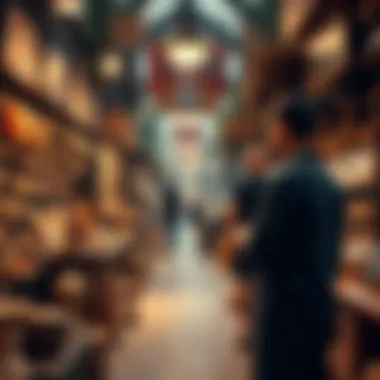
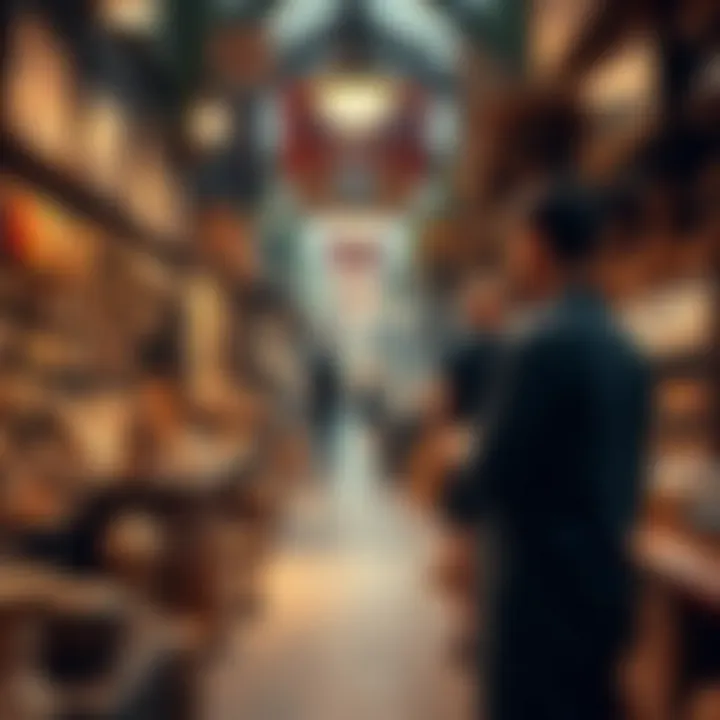
In sum, these key areas for city walks in Dubai not only enrich the urban experience but also carry significant implications for the property landscape. As urban planning continues to evolve, the relationship between city walks and real estate value will remain crucial for investors and homeowners alike.
The Impact of Architecture on City Walks
Architecture plays a crucial role in shaping the city walk experience in Dubai. It's more than just buildings; it’s the interplay of various structures, landscapes, and the urban fabric that determines how residents and visitors interact with their environment. The walkways, parks, and gathering spaces contribute to a unique urban journey, influencing everything from aesthetic appreciation to safety and comfort. In a city like Dubai, where the blend of cultures and modernity meets tradition, architectural diversity becomes a vital component of the narrative.
Contrasting Traditional and Modern Designs
Dubai is a canvas of architectural evolution that juxtaposes traditional designs with modern marvels. On one side, you have the Al Fahidi Historical Neighborhood, where the wind-tower architecture whispers stories of old Dubai. The narrow lanes and low-rise buildings evoke a sense of intimacy, encouraging exploration at a leisurely pace. Visitors can soak in the charm and history, experiencing the essence of the Emirati culture that once thrived in these streets.
On the flip side, you encounter the sleek and futuristic lines of structures like the Burj Khalifa. Its towering presence casts a shadow over the city, signifying the relentless drive towards modernization. These modern designs often incorporate glass and steel, creating a sense of vastness that contrasts sharply with the snug courtyards of traditional architecture. The mix draws a diverse crowd, with each group finding beauty and comfort in different styles.
The significant shaping of city walks stems from these contrasts. A stroll through the juxtaposition of dilapidated huts and towering skyscrapers provides a unique narrative thread. It speaks of the relentless spirit of growth and the vibrant blending of eras, reflecting the transitions within the city itself.
Sustainability in Urban Architecture
As awareness about environmental issues grows, sustainable architecture has taken root in Dubai's urban walkways. Buildings designed with efficiency and eco-friendliness in mind play a significant part in the overall quality of the walking experience. Green roofs, energy-efficient materials, and renewable energy systems are becoming more common. This shift not only enhances the aesthetics of the city but also reduces carbon footprints, making urban walks healthier and more enjoyable.
Moreover, public spaces are increasingly designed with sustainability as a core principle. Parks and plazas that rely on native vegetation and water-efficient landscaping support biodiversity, turning walking routes into mini-ecosystems. For example, the Dubai Water Canal area is not just a beautiful sight; it's an exemplary model of how urban architecture can work harmoniously with nature.
Through sustainable designs, city walks encourage community interaction while fostering a strong connection to the environment. As more walkways integrate eco-friendly principles and aesthetics, they contribute positively to both social dynamics and environmental responsibility.
"The architectural tapestry of Dubai serves as both a shelter and a stage, where every city walk unfolds a story woven with threads of time, culture, and sustainability."
Exploring Cultural Elements through City Walks
City walks in Dubai offer a rich tapestry of cultural experiences, allowing both residents and visitors alike to engage with the local heritage, art, and community spirit. These walks serve as a bridge between traditional aspects of culture and the modern innovations that Dubai embodies. By diving deeper into the cultural components within city walks, this section highlights their significance in understanding Dubai’s identity and connectivity.
The importance of exploring cultural elements during city walks cannot be overstated. Engaging with diverse neighborhoods reveals the deep-rooted customs and contemporary expressions that coexist in Dubai. Furthermore, as individuals navigate through the city streets, they often stumble upon art installations, traditional marketplaces, and gastronomic delights that tell stories of the past and present. This immersive experience plays a crucial role in weaving a sense of community, forming bonds among individuals from varied backgrounds, and enhancing appreciation for local stories.
Cultural Attractions Along the Walks
Engaging with cultural attractions during city walks in Dubai can be a transformative experience. For instance, the Al Fahidi Historical Neighborhood allows one to wander through narrow lanes lined with beautifully preserved wind-tower buildings, providing a glimpse into the emirate's rich past. This area doesn’t merely represent Dubai’s history; it invites you to partake in it.
Visitors can find the Sheikh Mohammed Centre for Cultural Understanding here, where programs aim to demystify Emirati culture through interactive experiences. Strolling through the neighborhood, one might also encounter art galleries showcasing masterpieces from local artists, creating a vibrant backdrop that depicts the contemporary art scene.
Other notable attractions include the Dubai Museum located in the Al Fahidi Fort, which houses an extensive collection of artifacts that illustrate Dubai's transformation from a fishing village to a dazzling metropolis. Such sites are not merely of historical importance; they also serve as hubs where stories are exchanged and cultures intermingle.
Events and Festivals Enhancing Urban Experience
Events and festivals loom large in the cultural landscape of Dubai, acting as key touchpoints for connection. Various cultural celebrations throughout the year offer a unique chance for immersive experiences within the urban milieu. For example, the Dubai Shopping Festival isn’t just about retail; it incorporates street performances, art installations, and food fairs that give visitors a true taste of local culture.
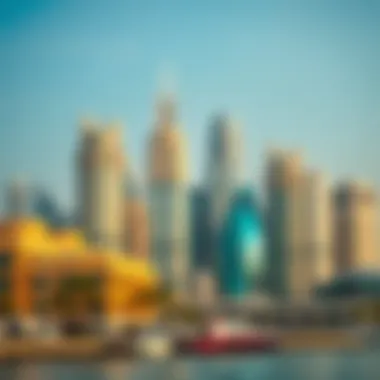
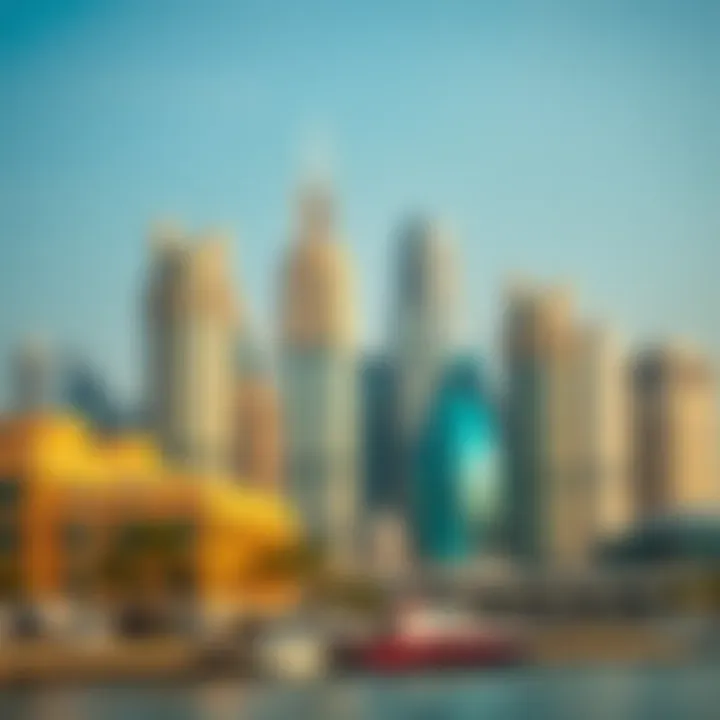
Key annual events include:
- Dubai Art Season: Celebrated with various exhibitions, installations, and art walks that transform the city's spaces into a vibrant canvas.
- Dubai Food Festival: Offers a culinary exploration, spotlighting everything from traditional Emirati dishes to modern fusion cuisine, attracting gourmets and novices alike.
- UAE National Day Celebrations: A day filled with parades, fireworks, and cultural performances, engaging the entire community and honoring national heritage.
Through these events, cultural elements intertwine with urban life, fostering community ties and encouraging participation from both locals and visitors. They illuminate how a city can rise through diversity, allowing various cultural narratives to flourish side by side.
Challenges and Future of Urban Walking in Dubai
Urban walking in Dubai is not just a leisurely pursuit; it’s a vital aspect of the city’s evolving identity. As the city continues to expand, understanding the challenges faced and the future possibilities can provide insight for investors, homeowners, expatriates, and community members alike. This section examines how infrastructure, safety, and an inclusive approach to urban planning play crucial roles in enhancing Dubai's walkable landscapes.
Infrastructure and Safety Concerns
When it comes to urban walking in Dubai, infrastructure is the bedrock upon which all else is built. While the emirate has invested heavily in modern amenities, several gaps still remain. For instance, many areas lack proper pedestrian pathways which makes strolling a bit of a treacherous task. Sidewalks may vanish abruptly, or become too narrow for comfort, and in some cases, are placed too close to speeding vehicles.
Furthermore, the challenge of public transport integration cannot be overlooked. Effective connections between metro stations and pedestrian-friendly zones can significantly enhance the urban walking experience. As it stands, not all transit nodes are designed with foot traffic in mind. This can discourage a significant number of residents or tourists from opting to walk.
"A well-planned urban landscape where walking is prioritized can boost not only the physical health of citizens but also their social well-being."
Safety, intertwined with infrastructure, is paramount. Adequate lighting and well-maintained public spaces contribute to a perception of security that encourages more people to take to the streets on foot. A walk in Dubai should be enjoyable, not nerve-wracking. Solutions like increased surveillance, regular maintenance, and community engagement initiatives can help foster a safer and more inviting atmosphere.
Envisioning an Inclusive Urban Environment
As Dubai continues to develop, envisioning an inclusive urban environment will become ever more critical. The concept of walkability extends beyond merely having sidewalks. It encompasses the idea that all individuals, regardless of age or mobility, should have equal opportunities to traverse the city safely and comfortably. This is where community involvement plays a pivotal role.
Projects aimed at enhancing city walks should involve public insights and preferences. This participatory approach ensures that developments reflect the needs of those who live and work in Dubai. Furthermore, urban planners should consider elements that promote accessibility. Features like ramps, tactile paving for the visually impaired, and clear signage can make a world of difference.
Incorporating green spaces and community gathering spots along walking routes encourages social interaction, strengthening community ties. The addition of shaded areas and seating can also make walking more appealing in Dubai’s grilled climate.
In sum, as we navigate the road ahead in urban walking, a focus on inclusive strategies alongside robust infrastructure will shape the very essence of Dubai's urban identity. Investors and homeowners should take note: enhanced walkability not only elevates the appeal of residential areas but can also lead to higher property values and a more vibrant community life. Through collaboration between city planners, developers, and citizens, a brighter future for urban walks in Dubai awaits.
Finale: The Role of City Walks in Dubai's Urban Identity
City walks in Dubai are not merely a leisurely activity; they’re a reflection of the city's dynamic identity and an essential component of urban living. In recent years, walking-friendly environments have emerged as a focal point for enhancing both quality of life and social interaction. These walks serve as arteries to the city's heart, connecting various neighborhoods and giving both residents and visitors access to the myriad of experiences that Dubai has to offer. The blend of culture, architecture, and public spaces has redefined how people engage with their surroundings.
Integrating Urban Walks into Daily Life
Integrating city walks into everyday life is increasingly seen as vital in promoting a healthy lifestyle and fostering community ties. For many residents, a stroll through the city can replace a gym membership; walking serves as both fitness and exploration. Steps taken along the bustling promenades of Dubai Marina or through the quieter lanes of Al Fahidi can fuel one's sense of connection, not just to the environment but to other citizens as well. Regularly participating in these walks promotes wellbeing and instills a sense of belonging among the diverse population.
Moreover, businesses are also recognizing the advantage of pedestrian-friendly areas. Cafés, restaurants, and shops that are easily accessible for walkers stand to benefit from increased foot traffic, creating a thriving local economy supported by an active community. In this manner, integrating urban walks effectively becomes a catalyst for both personal and communal growth.
The Future of Real Estate in Walkable Areas
The ever-evolving landscape of Dubai points to a future where real estate values are increasingly influenced by walkability. As the demand for more sustainable living increases, developers are not only considering the structural aspects of properties but also their connection to pedestrian infrastructure. Properties that embody convenient access to robust city walkways are seen as more desirable and, therefore, commanding higher prices.
The rise of mixed-use developments, where residential, retail, and recreational facilities amalgamate, surrounds residents with options, encouraging a lifestyle centered around walking. Investors are likely to find real estate in these areas a wise choice as they not only offer a place to live but also foster a connected community.
"Walking provides a practical way to engage with cities, enriching experiences and creating lasting memories."
For further insights on urban landscapes and community integration, consider visiting Wikipedia, Britannica, or community forums on Reddit.
